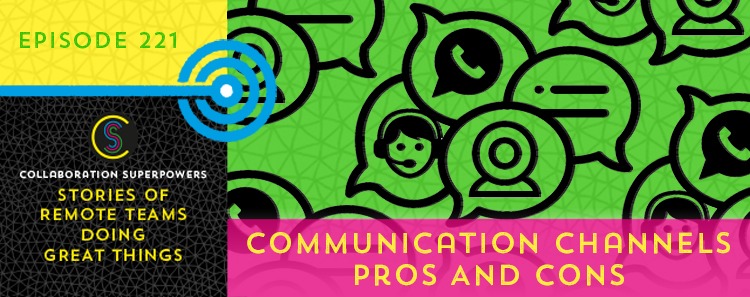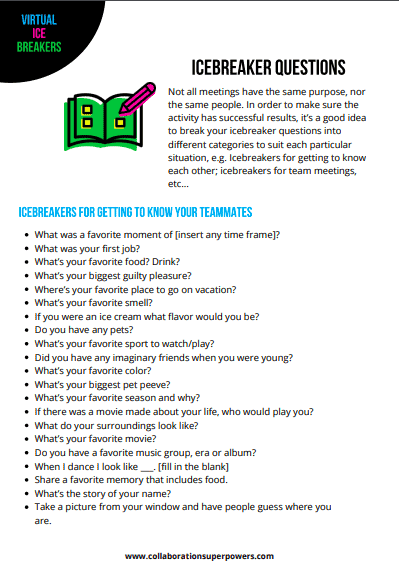COMMUNICATION CHANNEL PROS AND CONS
BEST METHODS TO COMMUNICATE WITH OUR VIRTUAL COLLEAGUES
Various ways to communicate with virtual colleagues include face-to-face, video, email, group chat, phone, and social media. Each method has its advantages and disadvantages. Understanding these communication pros and cons helps us choose the most suitable methods.
General communication channel tips
“Stick to the facts online and save the complicated emotional stuff for a higher bandwidth channel like face-to-face or video.” – Peter Hilton
- Let others know your communication preferences with a PERSONAL USER MANUAL.
- Create a TEAM AGREEMENT with your team and outline your communication etiquette.
- Changing mediums when conversations stall can also yield better results.
- It’s helpful to reconsider our communication approaches periodically.
Communication channel pros and cons
FACE-TO-FACE
Face-to-face communication stands as the most powerful and efficient method. It allows for using all senses, spontaneous interaction, and collective discussions. However, travel requirements and potential stress during challenging conversations are notable drawbacks.
- PROs
- Enables the use of all senses and non-verbal cues like body language.
- Enables building strong personal connections.
- Fosters immediate feedback.
- Allows interruption and real-time interaction in a group setting.
- Supports extended discussions without online fatigue.
- Eliminates remote tech challenges.
- CONs
- Requires travel and physical presence.
- Distractions in group settings.
- Surprises, interruptions, noise, or heated conversations can cause more stress to specific individuals.
VIDEO CALLS
Following closely after face-to-face interactions, video calls offer the advantage of visual cues and real-time engagement. They eliminate travel while supporting screen sharing. Yet, technical challenges, internet connectivity, and potential virtual fatigue can pose challenges.
- PROs
- Provides visual cues and real-time interaction.
- Offers a compromise between face-to-face and remote communication.
- Eliminates travel time and expense.
- Reduces hierarchy.
- Enhances collaboration with screen sharing.
- CONs
- Can feel less personal than in-person interactions.
- Technical software and hardware challenges.
- Relies on technology and a solid internet connection.
- Limited eye contact and background noise issues.
- Requires good lighting and scheduling coordination.
- Too many calls can lead to virtual fatigue.
AGREE WITH YOUR TEAM WHICH COMMUNICATION CHANNEL TO USE IN SPECIFIC SITUATION!
“If your house is on fire, you’re not going to email the fire department.” – Beat Buhlmann, General Manager, EMEA, Evernote
CREATE A TEAM AGREEMENT
PHONE CALLS
For situations with limited bandwidth or relaxed settings, phone calls offer accessible and swift communication. While lacking visual cues, phone calls are efficient. However, they can interrupt tasks and lack a documented record.
- PROs
- Accessible and efficient. Suitable for urgent matters.
- Fast and convenient option.
- CONS
- Lacks visual cues.
- Limited for conveying complex information.
- Calls can be disruptive.
- No record of a conversation.
- Difficult in group calls with multitasking.
Email provides convenience and adaptability, allowing for precise messaging and attachments. It accommodates flexible response times and maintains a written trail. Yet, it’s prone to flooding, unclear tone, and potential spam issues.
- PROs
- Convenient and flexible.
- Offers adjustable response time.
- Allows for crafting thoughtful and precise messages
- Supports sharing attachments.
- Provides a written record.
- CONs
- Risk of overcommunication and overwhelm.
- Lacks immediate interaction and feedback.
- Susceptible to spam.
- Tone can be unclear in written messages and may not convey emotions well.
GROUP CHAT
Group chat is an efficient way to engage in discussions with larger teams. It fosters transparency and quick exchanges, accommodating asynchronous conversations. However, information overload and challenges in maintaining work-life balance are considerations. Basecamp has a great article summarizing the pros and cons of group chat.
- PROs
- Enables large group asynchronous conversations.
- Supports collaboration across time zones.
- Enables a wide variety of channel topics.
- Supports and encourages transparent discussions.
- Quick, short messages.
- Organizes discussions and provides a record.
- Can help create a sense of belonging.
- CONs
- Group chat can lead to information overload.
- Tone ambiguity in the text can lead to lack of context and misunderstandings.
- Blurs work-life boundaries.
- Potential for constant conversation or creating an “ASAP culture”.
- Finding information at a later date can be challenging.
- Challenges in maintaining organized conversations as groups grow larger.
SOCIAL MEDIA
Social media offers a global reach and facilitates networking and public dialogues. It’s a means of sharing information and connecting with a broad audience. However, the presence of trolls and bad actors can be a downside.
- PROs
- Reaches a broad global audience.
- Fosters engagement with a diverse audience
- Facilitates networking, team building, and public discussions.
- CONs
- Exposure to negative interactions and online harassment.
- Potential for misinformation to spread.
- Requires management of privacy and security.

COLLABORATIONSUPERPOWERSPODCAST
SUBSCRIBE TO THE PODCAST
ITUNES
SPOTIFY
ABOUT THE PODCAST
Interviews packed with stories and tips for those whose business models depend upon successfully bridging distance!
RELATED RESOURCES
Check out some of our all-time favorite resources for meetings.

